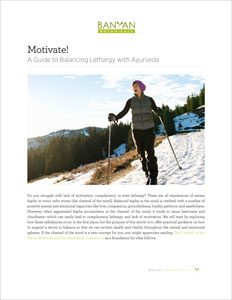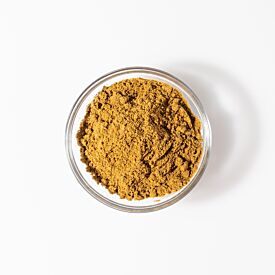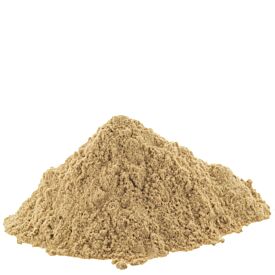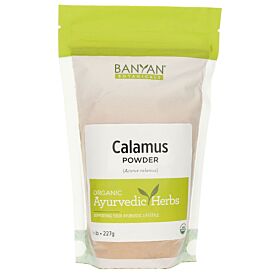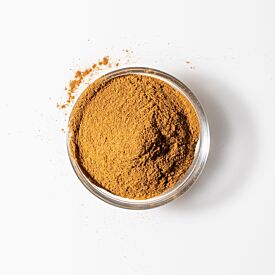Motivate!

Do you struggle with lack of motivation, complacency, or even lethargy? These are all expressions of excess kapha in mano vaha srotas (the channel of the mind). Balanced kapha in the mind is credited with a number of positive mental and emotional capacities like love, compassion, groundedness, loyalty, patience, and easefulness.
However, when aggravated kapha accumulates in the channel of the mind, it tends to cause heaviness and cloudiness—which can easily lead to complacency, lethargy, and lack of motivation.
We will start by exploring how these imbalances occur in the first place, but the purpose of this article is to offer practical guidance on how to support a return to balance so that we can reclaim health and vitality throughout the mental and emotional spheres.
If the channel of the mind is a new concept for you, you might appreciate reading The Channel of the Mind: Ayurveda and the Mind-Body Connection as a foundation for what follows.
Like Increases Like
Ayurveda operates on the premise that like increases like, and that opposites balance. Kapha dosha is naturally heavy, slow, cool, oily, smooth, dense, stable, gross, and cloudy.
Therefore, exposure to these qualities—whether through our diets, lifestyle habits, relationships, or experiences—tends to increase kapha.
On the other hand, kapha is balanced by foods and experiences that are light, warm, dry, rough, mobile, subtle, and clear.
Balancing Lethargy
Complacency and lethargy are very common expressions of excess kapha, and these imbalances are particularly likely to be triggered by excesses in the heavy, slow, cool, dense, and stable qualities.
Therefore, using diet, lifestyle, and supportive herbs to increase our exposure to light, sharp, hot, and mobile influences will generally serve to balance tendencies toward lethargy.
These qualities help to restore balance by stimulating and warming kapha, preventing stagnation, and encouraging proper circulation and movement throughout the mind and body.
A Supportive Diet
According to Ayurveda, agni (the digestive fire), is the very groundwork of optimal health, and also the root of all imbalances.
Elevated kapha, with its heavy, slow, cool, and stable qualities, acts in direct opposition to agni’s light, sharp, hot, and spreading nature, and can dampen the digestive fire—leaving it rather slow and sluggish. When this occurs, the entire system is affected.
But precisely because kapha is the densest of the three doshas, it responds well to concrete, physical therapies. Ingesting balancing fluids, foods, and agni-kindling herbs offers a substantive, and effective means of pacifying kapha—while very directly supporting agni.
Thankfully, even rather minor dietary adjustments can go a long way toward promoting balance, but a kapha-pacifying diet that prevents the accumulation of excess heaviness, density, and stagnation in the body is one of the most potent therapies around for balancing lethargy.
The following dietary habits are particularly adept at eliminating excess kapha from the system.
- Favor foods and drinks that are both energetically warming, and served either warm or hot.
- Favor a wide-variety of heating spices, like chili, black pepper, cayenne pepper, ginger, cinnamon, and cumin
- Favor the pungent, bitter, and astringent tastes, while minimizing the sweet, sour, and salty tastes.
- Enjoy light, dry, and warm foods and drinks, and avoid drinks that are colder than room temperature.
- Build your meals around healthy whole foods, and include a wide variety of fresh vegetables.
- Avoid especially heavy, dense, oily, and cold foods and drinks.
- Minimize processed foods, fried foods, and refined sugars.
In addition, keep in mind that most spices are kapha-pacifying, so feel free to spice up your meals (and your life) with a plethora of herbs and spices—both familiar and exotic. Use ginger—either fresh or powdered—as often as you like, as it is very clarifying, agni-kindling, and detoxifying.
And for further guidance, feel free to explore our more specific list of foods to favor and avoid when pacifying kapha.
Supportive Lifestyle Habits
Lifestyle therapies provide another powerful means of balancing kapha. While kapha is the densest of the doshas, the channel of the mind is rather subtle, and will generally be responsive to subtle changes in energy.
Thus, relatively small lifestyle changes can often serve to quickly and efficiently alter the influence that kapha has on the mind. The following lifestyle habits are particularly adept at loosening and eliminating elevated kapha from the mind.
A Kapha-Pacifying Routine
Nearly everywhere we look in nature, there are creatures engaging in some sort of consistent daily routine that is deeply influenced by the rhythms of nature—the rising and setting of the sun, the cycles of the seasons, and the underlying impulses directing the broader community of life.
While there is often some degree of seasonal variation, many plants and animals embrace a predictable daily rhythm and, as a rule, live by it.
As humans, we have largely gotten away from this habit. We engage with life at all hours of the day and night, and many of us have jobs and other obligations that require us to keep irregular schedules.
But at the most fundamental level, our physiology is very much adapted to—and supported by—some sense of regularity. Actually, this is precisely why the daily routine is such an effective therapy.
While kapha has to be careful not to get into a well-worn rut and does well to change things up periodically, the fact remains that having a simple routine can be helpful. It creates a number of familiar and comforting reference points throughout each day and sends a resounding affirmation to the deep tissues of the body that all is well, that we can be at ease.
When the body becomes accustomed to—and learns to count on—a daily routine that includes things like adequate rest, appropriate exercise, and a nourishing spiritual practice, the mind and the nervous system naturally begin to relax and can entertain more lightness and clarity.1
Each day, our routines provide us with a tangible opportunity to prioritize our own health and well-being, regardless of what else might be going on in our lives. They become poignant reminders that we are, in fact, worthy of a healthy dose of loving attention every single day.
The cumulative effect of caring for ourselves in this way is quite powerful, deeply kapha-pacifying, and for many, results in a greatly improved sense of wellness in a very short period of time.
But because kapha tends to be overly habitual, it’s important to implement a loose structural framework of a routine, with lots of room to accommodate (and encourage) inspiration and spontaneity.
In other words, when kapha is aggravated, get a few basics in place, stick with them, and allow the magic to happen in the spaces in-between.
Consider starting with this simple framework:
- Wake up at the same time from one day to the next, ideally before 6 a.m.
- Eat your meals at about the same times each day, knowing that, for some, two meals per day may be plenty.
- Go to sleep at a consistent time, preferably not before 10 p.m.
- To complement this foundation, choose two or three of the below strategies and commit to observing them daily.
- Stick with this framework for at least a month and observe the impact it has on your mind during that time.
Remember, you can always add more to your routine as the lethargy resolves and as your system comes into better alignment with your natural state of balance. For now, keep your commitments manageable, and remain open to being inspired.
Appropriate Exercise
When it comes right down to it, exercise is one of the most important therapies to implement when trying to balance excess kapha anywhere in the body, but especially in the mind. When engaged appropriately, exercise can be a panacea for improved health.
Proper exercise helps to release accumulated tension, clear stagnant mental and emotional energy, improve circulation, bolster the body’s detoxification mechanisms, kindle agni, and encourage proper elimination—all of which help to ensure a balanced state of mind.
Ayurveda offers the unique perspective that the type, duration, and intensity of exercise that is most balancing for each of us varies according to our constitution and our current state of balance—if you are unsure of yours, take our Ayurvedic Profile™ quiz.
In general, Ayurveda suggests that we exercise to only about fifty percent of our capacity—until we break a mild sweat on the forehead, under the arms, and along the spine, or until the first signs of dryness in the mouth.2, 3
Supportive activities include brisk walking, jogging, hiking, swimming, cycling, martial arts, and other forms of strength-building, aerobic exercise. Kapha-pacifying yoga is also very appropriate.
Exercise in the morning or evening (from about 6-10 a.m. or p.m.) will be the most supportive, as these are the kapha times of day.
If you are not currently exercising regularly, keep in mind that a supportive exercise program does not have to be complex or time-intensive. A daily twenty-minute brisk walk can do wonders for the entire system—body, mind, and spirit.
Nasya
Nasya, the practice of applying medicated oil to the upper nasal passages, is actually seen as a way of offering deeply influential therapy directly to the tissues of the brain.
This practice soothes the delicate tissues of the nose, fosters unobstructed breathing, relieves accumulated stress, promotes mental clarity, and awakens and generally supports the mind.
Nasya Oil is balancing for all three doshas but has an appropriate amount of stimulating energy to effectively pacify kapha in the mind. It is enlivening, uplifting, and balancing all at once. Start with 3–5 drops in each nostril in the morning, on an empty stomach.
If you are new to the practice of nasya, please see our helpful instructional video. Nasya should not be performed by pregnant or menstruating women.
Udvartana (Dry Powder Massage)
Udvartana is the practice of massaging the body with a dry powder (like chickpea flour), which is dry, light, stimulating, and very effective at clearing stagnation from the tissues.
This practice balances kapha throughout the body, encourages the movement of the lymphatic tissue, promotes circulation, liquefies fat, and, if you practice abhyanga (Ayurvedic self-massage), helps remove excess oil from the skin after an oil massage.4
A powder can be used instead of, or in conjunction with, traditional oil massage. Try chickpea flour, rice flour, or Calamus powder. This practice can be performed one to three times per week, or even daily.
For anyone prone to dryness, complement a daily practice with at least some oil massage to ensure that the tissues and the skin remain properly lubricated.
Kapha-Pacifying Oil Massage
If you are interested in adding an oil massage, which is a profound rejuvenative practice benefitting both the physical body and the more subtle realms of consciousness, be sure to choose a kapha-pacifying oil like Kapha Massage Oil or Sesame Oil.
In the morning, before a shower or bath, simply massage about ¼ cup of your chosen oil into the skin, hair, and scalp.
Let the oil soak in for a few minutes, and then you can massage your entire body with a dry powder before you rinse off in the shower.
For further instructions and a helpful instructional video on this rejuvenating technique, please click here.
Mindfulness Practices
It takes both time and focused attention to re-pattern the mind, and daily practice is one of the best ways to ensure your success.
Remarkably, as little as fifteen minutes per day is enough to be transformative, and committing to a daily practice will deliver results rather quickly.
If you are serious about transforming your lack of motivation, choose at least one of the following practices and commit to doing it on a daily basis:
Meditation or Prayer
Both meditation and prayer tap into the subtle channels of the mind and can help to re-pattern even our most habituated responses to challenging situations.
These practices serve to clear and quiet the channels of the mind, support the nourishing and enlivening flow of prana (the vital breath) throughout the system, release unresolved emotions, and encourage the proper digestion of food, thoughts, and experiences—all of which can help to ease tendencies toward lethargy.
If you do not have an established practice, So Hum Meditation can help to bring light and focus to a cloudy and burdened mind; this is a beautiful practice suitable to most anyone.
Pranayama
Stimulated by and carried on the breath, prana infuses every cell and tissue throughout the body with life. The practice of specific pranayamas (yogic breathing exercises aimed at balancing the movement of prana throughout the system) can be quite a potent means of soothing tendencies toward complacency or lethargy.
In general, pranayama helps to restore fluidity and vitality to the subtle energy channels of the body, releases accumulated tension, fosters a sense of clarity in the mind, and is deeply supportive of the nervous system.
Pranayama also activates and balances many of the most significant subtle channels influencing the mind, including mano vaha srotas (the channel of the mind), prana vaha srotas (the prana-carrying channel), ida nadi (the lunar, feminine channel), pingala nadi (the solar, masculine channel), and sushumna nadi (the central channel).
Therefore, pranayama is a powerful means of accessing and resetting longstanding psycho-spiritual patterns.
For a more detailed exploration of these subtle channels and their significance in the broader landscape of the body, please see the following resources:
- The Channel of the Mind: Ayurveda and the Mind-Body Connection
- Vibrant Heart: An Ayurvedic Guide to Heart Health.
If you are new to pranayama, start with full yogic breath to ensure that you are breathing correctly.
Once you feel comfortable, consider working with bhastrika (bellows breath) and kapalabhati (skull shining breath), both of which help to awaken and clear the mind, cleanse the tissues, kindle agni, and awaken prana in the body.
Ujjayi pranayama (breath of victory) is also very supportive. Start with just ten to fifteen minutes each day and notice what happens.
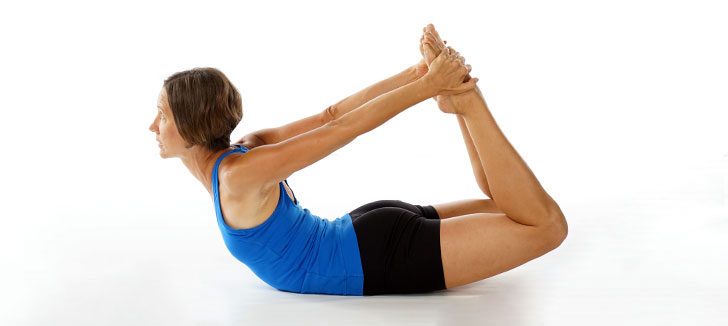
Yoga
Yoga positively impacts the mind in very similar ways. It moves prana in the body, helps to dissipate tension, clears stagnation, and encourages fluidity throughout the tissues, the subtle body, and the mind. Yoga also stimulates circulation and serves as a balanced form of exercise, which is among the more important therapies when balancing lethargy.
Favor kapha-pacifying yoga with a particular emphasis on standing poses, back bends, and especially kapha-pacifying poses like breath of joy, chair, cobra, and bow. Or, if you prefer a flow, sun salutations are often wonderfully supportive.
Herbs for Stimulating the Mind
Mental Clarity
Mental Clarity tablets offer deep support to both the brain and the nervous system. This formula helps clear the mind while encouraging concentration, intelligence, mental health, and emotional stability.
Bacopa
Bacopa powder is an excellent rejuvenative for the mind and the nerves. It also promotes memory, intelligence, clarity, concentration, and awareness, while fostering a sense of balance in the mind.
Tulsi
Tulsi removes excess kapha from the body while promoting healthy circulation, and strong digestion. It is also very sattvic in nature and it serves to elevate awareness, mental clarity, and the energy of love.
This plant is so highly revered in India that it is often kept in and around the home for its deeply purifying and beneficial properties. We offer Tulsi tablets, Tulsi liquid extract, and Tulsi powder.
Ayurvedic Teas
Speaking of CCF, this blend is also the base for two wonderfully supportive Ayurvedic tea blends—Joyful Heart, which helps lift the spirits and promote positivity, and Detox Digest, which nourishes and enkindles the digestive fire.
Triphala
Triphala is revered for its unique ability to gently cleanse and detoxify the digestive tract while replenishing, nourishing, and rejuvenating the tissues. It encourages balanced agni throughout the system, helps to eliminate ama (toxins), and is a general tonic for good health.
About half an hour before bed, take two Triphala tablets with a glass of warm water. If you prefer, steep ½–1 teaspoon Triphala powder in a cup of freshly boiled water for ten minutes. Cool and drink. Or try thirty drops of Triphala liquid extract in warm water before bed.
Healthy Kapha
Healthy Kapha tablets are specially formulated with herbs to help balance kapha systemically and can certainly help calm excess kapha in the mind. They can be taken with or without food once or twice daily, or as directed by your practitioner.
Kapha Digest / Trikatu
If excess kapha has accumulated in your digestive system, you can more specifically support balanced digestion and elimination (while clearing excess kapha from the gastrointestinal tract) with Kapha Digest tablets or Trikatu powder (the powdered form of the Kapha Digest formula that can be taken alone or sprinkled on your food like pepper).
Additional Resources
Keep in mind that lethargy does not develop in a vacuum. This and other emotional tendencies crop up only within the larger context of who we are—body, mind, and spirit. If you feel inspired to study the bigger picture, we have a number of other articles that may further inform your journey towards optimal health.
The following resources are particularly relevant to the topics of complacency, lethargy, and elevated kapha in the mind:
The Importance of Healthy Digestion introduces the concept of agni (which is the very foundation of health) and offers an in-depth exploration of the importance of tending to yours. As we have seen, tending to agni is often an important first step in balancing kapha.
Our Guide to Healthy Elimination is relevant due to the natural connection between overall health and digestive health, which of course, is reflected in the quality of our elimination.
Allergy Free is an introduction to the Ayurvedic perspective on allergies. If allergies play a part in your lack of motivation or lethargy, you may find this resource especially helpful.
Breathe Easy is a guide to lung and sinus health, with practical tips for addressing any number of imbalances. Lung and sinus congestion are common signs of excess kapha, and these symptoms often go hand in hand with a heavy, foggy mind. If you struggle with these types of imbalances, consider this resource as a complement to your healing process.
Achieving Your Optimal Weight is an Ayurvedic guide to balancing body weight. Again, excess kapha and weight imbalances often go hand in hand. If you struggle with your weight, this resource may very well support your healing process.
An Ayurvedic Guide to Balanced Sleep is an extremely useful resource if you feel that your lack of motivation is causing you to oversleep, or if oversleep is contributing to your sense of lethargy.
An Ayurvedic Guide to Stress Management explores fantastic tools for reducing stress and for changing our relationship with stressful situations. Stress can be a trigger for lethargy and depression. If this is the case for you, consider using this resource as additional support.
Vibrant Heart explores the critical connection between the mind, the heart, and the subtle channels of the energetic body. This article can be an insightful resource, and also offers practical guidance on how to balance emotional discord with more attention on the heart center.
Our Winter Season and Spring Season guides suggest a number of strategies for pacifying kapha and for staying warm, dry, and engaged—both mind and body—during the potentially aggravating winter and spring seasons.
Address Lethargy Your Way
Remember, one of the primary tenets of Ayurveda is that we should treat individuals—not their symptoms. Balancing lethargy is no exception.
While the above suggestions are aimed at curbing tendencies toward complacency, each of us has a different constellation of influences affecting our overall health. Factors such as constitution, current state of balance, age, environment, khavaigunyas (personal weaknesses), and the season, can be important considerations in crafting an effective treatment plan.
This is why working with a qualified Ayurvedic practitioner can be invaluable. Rather than sifting through a long list of possible remedies, you can focus on those that would most deeply serve your system in particular.
Even if you are navigating an Ayurvedic lifestyle on your own, it is critical to understand that who you are is a far more important consideration than the particular ailments that you may be trying to correct. This is your adventure. Chances are that the therapeutic strategies that most resonate with you will have a particularly potent impact on your state of balance.
So listen to your body, your heart, and your intuition. Trust your gut. Follow your inspiration. Keep it simple. Go slow. Find ways to stay motivated. And most importantly, enjoy the process.
We sincerely hope that we can continue to support you in cultivating an engaged mind, a contented heart, and vibrant overall health.


